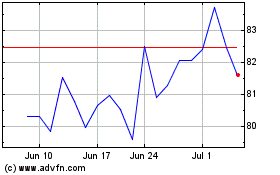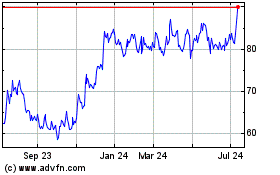Market Tumble Prompts Reaction from UMB CIO Bill Greiner
March 01 2007 - 11:02AM
Business Wire
The following analysis and opinion has been developed by UMB Chief
Investment Officer Bill Greiner and UMB Investment Advisors, a
division of UMB Financial Corporation (NASDAQ: UMBF). The Author
Bill Greiner was named Business Week �Fearless Forecaster: 2005
Stock Market Strategist of the Year� in December 2005. He received
this distinction by being the investment strategist who most
accurately forecasted where the U.S. markets would end up at the
close of 2005. Greiner has spent his entire career in the
investment field, with more than 27 years of investment management
experience. Perspective The market experienced a remarkable drop
Tuesday, closing down more than 400 points on the Dow Jones
industrial average. The drivers were many, but among them would
include: Time: it has been more than three years since we have seen
at least a 2% intra-day downside move on the Dow. Market historians
have to go back to the early 1950�s to report a time of long-term,
limited volatility. The market has moved up more than 16% without a
significant counterbalance in market figures. This is unusual. On
Monday, Alan Greenspan mentioned the possibility exists the U.S.
economy may be in recession prior to the end of the year. Tuesday,
reports on durable goods orders for January indicated a 7% drop
from the previous report and were down 3% excluding transportation
products. Analysts were expecting a �flat� reading. The Chinese
market was down more than 9% Monday night in price. This was driven
by new regulations from central planners who are concerned about
the amount of leverage and �speculation� within their market. Given
the market reaction to these notable events, it is essential to
consider the following factors. First, Durable Goods order data is
among the most volatile data released by Washington on a regular
basis. Significant �swings� can, and do, occur from these reports.
Assessing one month of data and reacting to it is not prudent.
Second, the Chinese market was up more than 10% over the previous
week. The 9% correction takes away one week of advance, perhaps not
a signal of a new, �bear� market. And third, it is important to
note the decline which occurred has been forecasted by many
analysts. So, how far down can we move during this market
correction? When the market produces extreme fluctuations, economic
trends have demonstrated that focusing and analyzing long-term
factors have made a difference in market sentiment and valuation.
At the fundamental core of those factors are corporate profits and
interest rates. Nothing that we have experienced in the last 48
hours would indicate corporate profit growth is going to be lower
than forecasted � 6-to-9% growth for this year. Plus, there is no
current data to indicate interest rates are headed significantly
higher. Indeed, the bond-futures indexes are reacting to the
probability the Fed will lower interest rates. This has increased
from a 0% probability two days ago to the current read of 40%
probability. So, it appears the needed pressures to increase rates
are currently not present to a large degree. Closing Comment Over
the last couple of days, the lone, substantive development that has
produced tremendous interest from Wall Street is Alan Greenspan�s
acknowledgement that we may see a recession start sometime during
2007. When someone of Mr. Greenspan�s capabilities talks about
recession, we need to at least take note. About UMB UMB Financial
Corporation is a multi-bank holding company headquartered in Kansas
City, Mo., offering complete banking, asset management and related
financial services to both individual and business customers
nationwide. Its banking subsidiaries own and operate 139 banking
centers throughout Missouri, Illinois, Colorado, Kansas, Oklahoma,
Nebraska and Arizona. Subsidiaries of the holding company and the
lead bank, UMB Bank, n.a., include an investment services group
based in Milwaukee, Wisconsin, a trust management company in South
Dakota, and single-purpose companies that deal with brokerage
services, consulting services and insurance.
UMB Financial (NASDAQ:UMBF)
Historical Stock Chart
From Aug 2024 to Sep 2024

UMB Financial (NASDAQ:UMBF)
Historical Stock Chart
From Sep 2023 to Sep 2024
